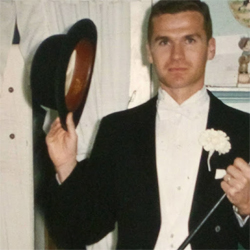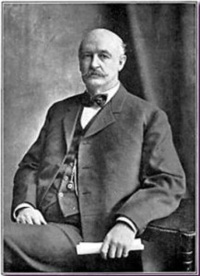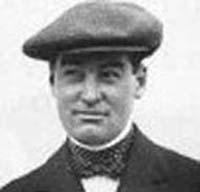|
|
|
 |
Dealing with ‘Doubting Thomas’ Syndrome
Posted on 18 March 2019, 9:06
Even though I have long followed the sport of track & field, I shake my head in disbelief when I look at the eight-foot ceiling in my house and try to visualize someone jumping over a bar that high. Yet, I know that the world record in the high jump is eight-feet, one-half inch, by Javier Sotomayor of Cuba, set on July 27, 1993. I didn’t see that world-record jump, but I can believe it, as I’ve seen other humans jump three or four inches under that height and I am familiar with the high standards of officiating in the sport. I don’t have to see it to believe it.
However, I have encountered countless skeptics who refuse to believe in certain psychic phenomena because they can’t do it themselves, because they’ve never witnessed it, or because it defies the laws of materialistic science. They suffer from “Doubting Thomas Syndrome,” so-called because the apostle Thomas refused to believe in the resurrected Christ until he could touch his wounds. I’ll admit that many things in the psychic realm which I’ve read or heard about exceed my boggle threshold and so I am skeptical to some degree or another. But when I read the testimony of distinguished scientists and scholars who have witnessed it countless times under controlled conditions, my skepticism begins to erode toward belief. Then again, when I see illusionists pull off amazing tricks on television, such as on “The Carbonaro Effect,” I begin to wonder if somehow those researchers were victims of some very clever illusionists. I’ll also admit to be being a pretend illusionist about 55 years ago (see photo).

I’ll usually reason my way back to a high degree of belief in the phenomenon by concluding that there is manipulation of some kind going on with the photography that the home viewer can’t see, but I continue to wonder how the victims of the trick on television are so easily duped. While I can accept that even world-renowned scientists, such as Sir William Crookes, who claimed to have witnessed floating accordions, levitations, and other amazing phenomena with medium D. D. Home, could have been duped a time or two, I struggle to believe that he and so many intelligent men and women could have been fooled dozens, even hundreds of times.
Professor Charles Richet, a Nobel Prize winner in medicine, claimed to have witnessed medium Eusapia Palladino more than 200 times. “Even if there were no other medium than Eusapia in the world, her manifestations would suffice to establish scientifically the reality of telekinesis and ectoplasmic forms,” said Richet, who also observed phenomena with many other mediums. “Yes, it is absurd; but no matter – it is true,” Richet asserted. It should be noted that even though Richet was certain no trickery was involved, he still refused to believe in spirits. He saw it as some kind of subconscious workings of the medium’s mind.
My friend Doug is also a long-time follower of track & field and has even written books about “unbelievable” feats in the athletic arena. He has no difficulty in accepting an eight-foot high jump, but he refuses to believe that anybody can bend a spoon without applying physical force. He believes that all reports of such a phenomenon are just so much hooey. Doug is a big fan of James “The Amazing” Randi and recalls that Randi supposedly exposed British psychic Uri Geller’s sleight of hand in spoon-bending on television some years ago. As I recall, there is another side to that story, but I don’t remember exactly what it is and I am not interested enough to research it.
About 15 years ago, I attended a conference in which a medium (I think it was Anne Gehman) gave a spoon-bending demonstration and then had forks and spoons distributed to all in the audience, around a hundred people. I don’t recall the ritual that the medium led us all through, but I believe it was something like closing our eyes and gently rubbing the neck of the spoon or fork between the thumb and the forefinger while visualizing it bending. However, I do recall that more than half the people in the audience, including my wife, Gina, had spoons and forks curl up on them without physical force being applied. Several people, including the woman sitting to my right, had the four prongs on the forks they were holding curl up into tight knots. I confess to being one of the failures that night.

When I told Doug about what I had observed at that conference, he still refused to believe it possible. The closed eyes and the light finger rubbing suggested fraud to him. He asked that Gina demonstrate the next time we visit his neck of the woods. I told him that she really hasn’t tried to bend a spoon since then, but I’m pretty sure that if she were to try it again in front of him that she would fail. Doug saw my reply as an admission that we were somehow duped, even though we don’t know how we were duped. When I told him we still had the spoon (see photo), he suggested we have a metallurgical test done on it and we would discover that it was a special cheap metal that bent from the friction generated by the heat from the light rubbing.
If you put “spoon-bending” into an Internet search, you’ll get the skeptic’s view on how it is done while also finding a few explanations suggesting real telekinetic or psychokinetic powers, or mind over matter. One such site states that you have to “be one with spoon” and feel the energy between your fingers.
I don’t know how the spoons curl up, but I am more inclined to accept some mind-over-matter explanation, possibly greatly enhanced by the group energy, over cheap metal. The four prongs curling up on the fork held by the person sitting to my right is ten times more mind-boggling to me than the curling of the spoon, especially since the woman’s fingers were supposed to be rubbing the neck of the fork and not the prongs. The skeptic will likely conclude that the woman was a “plant” by the medium. If so, there were many such plants in the audience.
I can’t explain it, but I do know that Gina was not trying to trick anybody and I am reasonably certain that the woman sitting next to me was not part of an act. I’m not a Doubting Thomas. If I were a Doubting Thomas, here are the questions I would have regarding that eight-foot high jump:
• How come Sotomayor never replicated that world-record jump?
• How come nobody has replicated it in more than a quarter century?
• How do we know the officials weren’t bribed by the Castro regime of Cuba?
• Did each of the officials have proper training in measuring techniques? Did at least one of them have a Ph.D. in mathematics?
• How do we know that the officials weren’t drugged and weren’t hallucinating?
• Could the officials have been hypnotized to think they were seeing 96.5 inches on the measuring device?
• How do we know that the measuring device wasn’t ‘doctored’ beforehand and off a few inches?
• Is the measuring device still available for calibration? If it is, how can we be sure it is the same one used 26 years ago?
• Was Sotomayor tested for performance-enhancing drugs? If so, could he have used one of those drugs that defies testing?
• Did anyone check Sotomayor’s shoes for hidden springs?
• Could an illusionist have been employed to make it appear that he cleared the bar when he actually went under it?
Is there anything we can accept as absolute truth?
Michael Tymn is the author of The Afterlife Revealed: What Happens After We Die, Resurrecting Leonora Piper: How Science Discovered the Afterlife, and Dead Men Talking: Afterlife Communication from World War I.
Next blog post: April 1
Read comments or post one of your own
|
 |
Awakening ‘In Times of War’
Posted on 04 March 2019, 9:18
An abundance of communication from the “Other Side” suggests that many souls are slow to recognize that they have departed the material life. That is, there seems to be a “sleep” or “dream” state that precedes the awareness that the consciousness is no longer in the physical body. “The duration of the state of confusion that follows death varies greatly,” explained Alan Kardec, the pioneering French psychical researcher of the 19th Century. “It may be only a few hours, and it may be of several months, or even years,” Kardec wrote. “Those with whom it lasts the least are they who, during the earthly life, have identified themselves most closely with their future state, because they are soonest able to understand their new situation.”
If Kardec is right, then the anthology titled In Times of War: Messages of Wisdom from Soldiers in the Afterlife should be required reading for any person who thinks he or she might die at some time in the future. It includes a number of stories in which battlefield victims struggled to understand what happened to them after they were killed. “Realize that those souls in the lower regions of the astral world are actually in a space near the ground of the physical planet,” automatic writing medium Elsa Barker received from the discarnate David Patterson Hatch (1846-1912), a former Los Angeles lawyer and judge (as set forth in one of the chapters of this book recently released by White Crow Books). “Those who hang over the battlefields where they met their fate are still thrilled or horrified by the noise of the battle horns; they can still hear the shriek of shells and feel the shattering force of the explosions. Day in, day out, these unfortunate earthbound ones live over and over again the emotions of war; night after night, they dread the morning when the sounds will begin again. They cannot get away. They are not free merely because their bodies are buried under a few feet of earth, or worse still left unburied.”
Hatch (below) related the story an English friend, an officer in an English regiment who was killed by a German bullet in the early days of the Great War. Because of his hate for a German living in London, one who had competed with him for the love of a woman, the officer transferred his hate for the man to all Germans. After being fatally shot, he was unconscious for a time and then “awakened” to the noise of a bursting shell. He immediately returned to the battle scene, saluted a superior officer, but got no response, which he found strange. He approached other soldiers, even touched one of them on the shoulder, but they paid no attention to him. “The smell of the coffee and the cooking meats brought temporary satisfaction to my friend,” Hatch continued. “He tried to drink from brandy flasks tilted to the mouths of men who could not see him or protest; he steeped himself in hungers and despairs. His companions were always changing themselves into the forms of the man he hated and the woman he loved. He witnessed their coarse lovemaking. Sometimes the simulacrum of the woman turned to him with a friendly word. He cursed her, but clung to her hand. But always she vanished when his mouth yearned to hers.” The man was living a nightmare brought on by his hatred before death and his unawareness of what happens after death.

The anthology begins with the story of Private Dowding, now something of a classic in the metaphysical genre. Dowding was a 37-year-old British soldier killed on the WWI battlefield. Communicating through the automatic writing mediumship of Wellesley Tudor Pole, Dowding told of his initial confusion. “If there is a shock, it is not the shock of physical death,” Dowding explained. “Shock comes later when comprehension dawns; ‘Where is my body? Surely, I am not dead!’” He recalled that he saw two friends carrying his body on a stretcher and assumed that he had been injured, although he was confused by the fact that he was walking behind them and yet seeing his body on the stretcher. “I seemed in a dream. I had dreamt that someone or something had knocked me down. Now I was dreaming that I was outside my body. Soon I should wake up and find myself in the traverse waiting to go on guard.”
In another story, a Polish pilot was shot down and killed in the crash. However, as he remembered it, he got out of his crashed plane, ran to hide from the Germans, and encountered some French peasants. When he asked them for help, they did not appear to see him. At some point, he came to realize he was no longer occupying his physical body. “What you expect here, that you find,” he communicated through a medium. “You build your awakening, it is just as you imagined, at least that is what they told me. I expected nothing, so nothing came. But now I am pulling out of the difficult doldrums and am beginning to feel my strength.”
A British tank officer recalled falling face downwards in a swampy mud and then remaining unconscious for a time in something of a nightmare. “It was a time of conscious paralysis,” he communicated. “I hated it, and when something snapped and I was free, I was awfully relieved.”
As times seems to take on a different form in the afterlife, it is never quite clear as to how long in earth time it takes for the departed soul to recognize he or she has given up the ghost. In the case of Alfred V. (believed to be New York sportsman and socialite Alfred Vanderbilt - below), who was one of many victims on the Lusitania, which was torpedoed by a German submarine on May 7, 1915, it seems to have been more than a year. On November 5, 1916, he communicated with Dr. Carl Wickland, a psychiatrist, through the trance mediumship of Wickland’s wife, Anna, claiming to be hungry and cold and his clothes all wet. Dr. Wickland then helped him understand his condition.

The Spiritualist classic, Claude’s Book (not included in this anthology), relates communication between Claude, a British pilot killed when shot down by the Germans in World War I, and his mother through the trance mediumship of Gladys Osborne Leonard (See my blog entry of 29 Oct. 2018 in archives at left). Early on, Claude explains his passing. He first felt a blow on his head, a sensation of dizziness and falling, and then nothing more. “It may have been a fortnight or more later that I became conscious again,” he told his mother through Leonard, further commenting that he had no account of time there, so he could not be sure.
The Preface to this anthology by editor Jon Beecher is a fascinating story in itself as he tells of his own “awakening” to the reality of a spirit world. Leading a very materialistic life and not believing in life after death, Beecher had a rude awakening in 2000. “I just banged my head and woke up to a whole new worldview,” he summarizes his 11-page story. In the book’s Conclusion, Beecher notes the saying, “You are what you eat,” and suggests that after physical death “we are what we think.” A person’s “moral specific gravity,” or his “goodness” during the earth life, seems to be a big factor in the awakening process, but, from the stories in this book, indications are that a conviction that the soul lives on in a greater reality significantly expedites the awakening process.
Michael Tymn is the author of The Afterlife Revealed: What Happens After We Die, Resurrecting Leonora Piper: How Science Discovered the Afterlife, and Dead Men Talking: Afterlife Communication from World War I.
Next blog post: March 18
Read comments or post one of your own
|
|
|
|